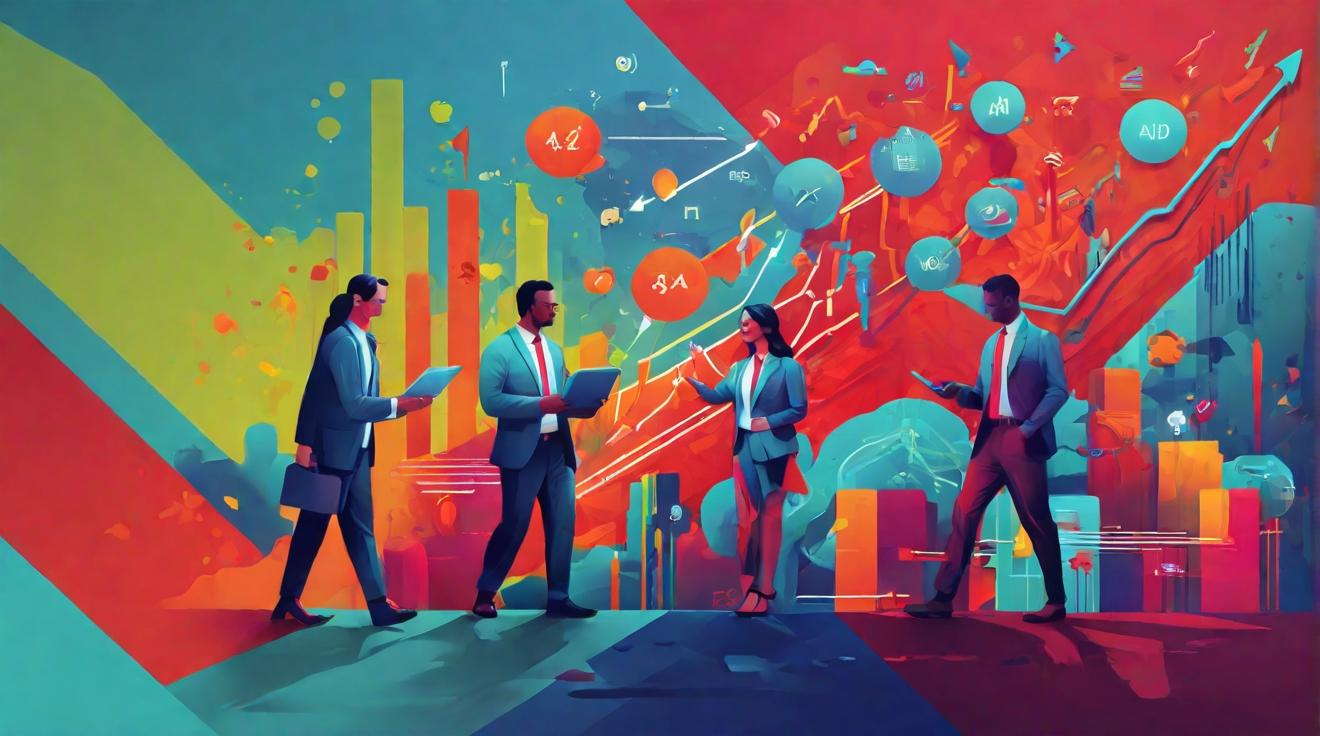While no products are imminent, Altman described the potential as “something big” and worth pursuing despite the lengthy development timeline. !-- wp:paragraph -->
FinOracleAI — Market View
OpenAI’s ambitious $850 billion infrastructure buildout signals a pivotal moment in AI’s evolution, underscoring the massive compute and energy demands driving the industry. While the scale raises legitimate concerns about market overheating and circular financing risks, the coordinated ecosystem approach and strategic energy investments provide a foundation for sustainable growth. !-- wp:paragraph -->- Opportunities: Meeting exponential AI demand through unprecedented infrastructure; strategic partnerships enhancing innovation capacity; energy investments supporting sustainability.
- Risks: Potential market bubble due to rapid valuation increases; high capital expenditure with uncertain near-term returns; dependency on energy solutions that are still developing.
- Long-term outlook: Despite short-term volatility, AI’s transformative potential is likely to generate significant societal and economic value.
Impact: OpenAI’s mega buildout represents a strategic bet on AI’s future, balancing immense growth opportunities against notable financial and operational risks in an evolving market landscape.
Beyond infrastructure, OpenAI is venturing into hardware innovation after acquiring Jony Ive’s startup for approximately $6.4 billion. Altman hinted at developing a limited range of devices that leverage AI’s breakthrough capabilities to redefine human-computer interaction. !-- wp:paragraph -->“Computers have never before been able to truly ‘understand and think.’ This breakthrough opens the door to inventing an entirely new way of using them.” — Sam Altman, OpenAI CEO While no products are imminent, Altman described the potential as “something big” and worth pursuing despite the lengthy development timeline.
!-- wp:paragraph -->FinOracleAI — Market View
OpenAI’s ambitious $850 billion infrastructure buildout signals a pivotal moment in AI’s evolution, underscoring the massive compute and energy demands driving the industry. While the scale raises legitimate concerns about market overheating and circular financing risks, the coordinated ecosystem approach and strategic energy investments provide a foundation for sustainable growth. !-- wp:paragraph -->- Opportunities: Meeting exponential AI demand through unprecedented infrastructure; strategic partnerships enhancing innovation capacity; energy investments supporting sustainability.
- Risks: Potential market bubble due to rapid valuation increases; high capital expenditure with uncertain near-term returns; dependency on energy solutions that are still developing.
- Long-term outlook: Despite short-term volatility, AI’s transformative potential is likely to generate significant societal and economic value.
Impact: OpenAI’s mega buildout represents a strategic bet on AI’s future, balancing immense growth opportunities against notable financial and operational risks in an evolving market landscape.
Tech giants tied to OpenAI, including Nvidia and Microsoft, have seen their combined market value soar to $8.1 trillion, roughly 13.5% of the S&P 500. This rapid valuation increase fuels skepticism about a potential market bubble, especially given OpenAI’s high cash burn and the scale of investments involved. !-- wp:paragraph --> Altman acknowledged that investment cycles historically involve periods of over- and under-investment, with corresponding financial winners and losers. He remains confident in AI’s long-term societal value despite short-term volatility. !-- wp:paragraph -->OpenAI’s Hardware Ambitions Following Jony Ive Acquisition
Beyond infrastructure, OpenAI is venturing into hardware innovation after acquiring Jony Ive’s startup for approximately $6.4 billion. Altman hinted at developing a limited range of devices that leverage AI’s breakthrough capabilities to redefine human-computer interaction. !-- wp:paragraph -->“Computers have never before been able to truly ‘understand and think.’ This breakthrough opens the door to inventing an entirely new way of using them.” — Sam Altman, OpenAI CEO While no products are imminent, Altman described the potential as “something big” and worth pursuing despite the lengthy development timeline.
!-- wp:paragraph -->FinOracleAI — Market View
OpenAI’s ambitious $850 billion infrastructure buildout signals a pivotal moment in AI’s evolution, underscoring the massive compute and energy demands driving the industry. While the scale raises legitimate concerns about market overheating and circular financing risks, the coordinated ecosystem approach and strategic energy investments provide a foundation for sustainable growth. !-- wp:paragraph -->- Opportunities: Meeting exponential AI demand through unprecedented infrastructure; strategic partnerships enhancing innovation capacity; energy investments supporting sustainability.
- Risks: Potential market bubble due to rapid valuation increases; high capital expenditure with uncertain near-term returns; dependency on energy solutions that are still developing.
- Long-term outlook: Despite short-term volatility, AI’s transformative potential is likely to generate significant societal and economic value.
Impact: OpenAI’s mega buildout represents a strategic bet on AI’s future, balancing immense growth opportunities against notable financial and operational risks in an evolving market landscape.
Tech giants tied to OpenAI, including Nvidia and Microsoft, have seen their combined market value soar to $8.1 trillion, roughly 13.5% of the S&P 500. This rapid valuation increase fuels skepticism about a potential market bubble, especially given OpenAI’s high cash burn and the scale of investments involved. !-- wp:paragraph --> Altman acknowledged that investment cycles historically involve periods of over- and under-investment, with corresponding financial winners and losers. He remains confident in AI’s long-term societal value despite short-term volatility. !-- wp:paragraph -->OpenAI’s Hardware Ambitions Following Jony Ive Acquisition
Beyond infrastructure, OpenAI is venturing into hardware innovation after acquiring Jony Ive’s startup for approximately $6.4 billion. Altman hinted at developing a limited range of devices that leverage AI’s breakthrough capabilities to redefine human-computer interaction. !-- wp:paragraph -->“Computers have never before been able to truly ‘understand and think.’ This breakthrough opens the door to inventing an entirely new way of using them.” — Sam Altman, OpenAI CEO While no products are imminent, Altman described the potential as “something big” and worth pursuing despite the lengthy development timeline.
!-- wp:paragraph -->FinOracleAI — Market View
OpenAI’s ambitious $850 billion infrastructure buildout signals a pivotal moment in AI’s evolution, underscoring the massive compute and energy demands driving the industry. While the scale raises legitimate concerns about market overheating and circular financing risks, the coordinated ecosystem approach and strategic energy investments provide a foundation for sustainable growth. !-- wp:paragraph -->- Opportunities: Meeting exponential AI demand through unprecedented infrastructure; strategic partnerships enhancing innovation capacity; energy investments supporting sustainability.
- Risks: Potential market bubble due to rapid valuation increases; high capital expenditure with uncertain near-term returns; dependency on energy solutions that are still developing.
- Long-term outlook: Despite short-term volatility, AI’s transformative potential is likely to generate significant societal and economic value.
Impact: OpenAI’s mega buildout represents a strategic bet on AI’s future, balancing immense growth opportunities against notable financial and operational risks in an evolving market landscape.
Oracle recently restructured its leadership to support this growth, promoting Clay Magouyrk and Mike Sicilia to CEO roles focused on cloud infrastructure. Nvidia continues to innovate with new accelerators designed to power next-generation AI workloads. !-- wp:paragraph -->Market Valuation Surge and Bubble Risk
Tech giants tied to OpenAI, including Nvidia and Microsoft, have seen their combined market value soar to $8.1 trillion, roughly 13.5% of the S&P 500. This rapid valuation increase fuels skepticism about a potential market bubble, especially given OpenAI’s high cash burn and the scale of investments involved. !-- wp:paragraph --> Altman acknowledged that investment cycles historically involve periods of over- and under-investment, with corresponding financial winners and losers. He remains confident in AI’s long-term societal value despite short-term volatility. !-- wp:paragraph -->OpenAI’s Hardware Ambitions Following Jony Ive Acquisition
Beyond infrastructure, OpenAI is venturing into hardware innovation after acquiring Jony Ive’s startup for approximately $6.4 billion. Altman hinted at developing a limited range of devices that leverage AI’s breakthrough capabilities to redefine human-computer interaction. !-- wp:paragraph -->“Computers have never before been able to truly ‘understand and think.’ This breakthrough opens the door to inventing an entirely new way of using them.” — Sam Altman, OpenAI CEO While no products are imminent, Altman described the potential as “something big” and worth pursuing despite the lengthy development timeline.
!-- wp:paragraph -->FinOracleAI — Market View
OpenAI’s ambitious $850 billion infrastructure buildout signals a pivotal moment in AI’s evolution, underscoring the massive compute and energy demands driving the industry. While the scale raises legitimate concerns about market overheating and circular financing risks, the coordinated ecosystem approach and strategic energy investments provide a foundation for sustainable growth. !-- wp:paragraph -->- Opportunities: Meeting exponential AI demand through unprecedented infrastructure; strategic partnerships enhancing innovation capacity; energy investments supporting sustainability.
- Risks: Potential market bubble due to rapid valuation increases; high capital expenditure with uncertain near-term returns; dependency on energy solutions that are still developing.
- Long-term outlook: Despite short-term volatility, AI’s transformative potential is likely to generate significant societal and economic value.
Impact: OpenAI’s mega buildout represents a strategic bet on AI’s future, balancing immense growth opportunities against notable financial and operational risks in an evolving market landscape.
The buildout involves intricate partnerships where companies such as Oracle, Nvidia, and SoftBank invest in and benefit from the projects through chip sales and data center leases. While some critics warn this model resembles circular financing, Friar argues it reflects a coordinated industry response to an unprecedented compute demand surge. !-- wp:paragraph -->“There’s not enough compute to do all the things AI can do, so we need to get it started — and we need to do it as a full ecosystem.” — Sarah Friar, OpenAI CFO Oracle recently restructured its leadership to support this growth, promoting Clay Magouyrk and Mike Sicilia to CEO roles focused on cloud infrastructure. Nvidia continues to innovate with new accelerators designed to power next-generation AI workloads.
!-- wp:paragraph -->Market Valuation Surge and Bubble Risk
Tech giants tied to OpenAI, including Nvidia and Microsoft, have seen their combined market value soar to $8.1 trillion, roughly 13.5% of the S&P 500. This rapid valuation increase fuels skepticism about a potential market bubble, especially given OpenAI’s high cash burn and the scale of investments involved. !-- wp:paragraph --> Altman acknowledged that investment cycles historically involve periods of over- and under-investment, with corresponding financial winners and losers. He remains confident in AI’s long-term societal value despite short-term volatility. !-- wp:paragraph -->OpenAI’s Hardware Ambitions Following Jony Ive Acquisition
Beyond infrastructure, OpenAI is venturing into hardware innovation after acquiring Jony Ive’s startup for approximately $6.4 billion. Altman hinted at developing a limited range of devices that leverage AI’s breakthrough capabilities to redefine human-computer interaction. !-- wp:paragraph -->“Computers have never before been able to truly ‘understand and think.’ This breakthrough opens the door to inventing an entirely new way of using them.” — Sam Altman, OpenAI CEO While no products are imminent, Altman described the potential as “something big” and worth pursuing despite the lengthy development timeline.
!-- wp:paragraph -->FinOracleAI — Market View
OpenAI’s ambitious $850 billion infrastructure buildout signals a pivotal moment in AI’s evolution, underscoring the massive compute and energy demands driving the industry. While the scale raises legitimate concerns about market overheating and circular financing risks, the coordinated ecosystem approach and strategic energy investments provide a foundation for sustainable growth. !-- wp:paragraph -->- Opportunities: Meeting exponential AI demand through unprecedented infrastructure; strategic partnerships enhancing innovation capacity; energy investments supporting sustainability.
- Risks: Potential market bubble due to rapid valuation increases; high capital expenditure with uncertain near-term returns; dependency on energy solutions that are still developing.
- Long-term outlook: Despite short-term volatility, AI’s transformative potential is likely to generate significant societal and economic value.
Impact: OpenAI’s mega buildout represents a strategic bet on AI’s future, balancing immense growth opportunities against notable financial and operational risks in an evolving market landscape.
The largest constraint on AI expansion is not capital or semiconductor supply but electricity availability. Altman has strategically invested in nuclear and fusion energy companies, such as Helion Energy and Oklo, viewing these technologies as essential to meet AI’s massive power requirements. !-- wp:paragraph --> OpenAI’s CFO, Sarah Friar, explained that partners like Oracle are leveraging their balance sheets to build these extensive data centers, with Nvidia providing equity alongside hardware to accelerate project completion. !-- wp:paragraph -->Strategic Partnerships and Complex Financing Structures
The buildout involves intricate partnerships where companies such as Oracle, Nvidia, and SoftBank invest in and benefit from the projects through chip sales and data center leases. While some critics warn this model resembles circular financing, Friar argues it reflects a coordinated industry response to an unprecedented compute demand surge. !-- wp:paragraph -->“There’s not enough compute to do all the things AI can do, so we need to get it started — and we need to do it as a full ecosystem.” — Sarah Friar, OpenAI CFO Oracle recently restructured its leadership to support this growth, promoting Clay Magouyrk and Mike Sicilia to CEO roles focused on cloud infrastructure. Nvidia continues to innovate with new accelerators designed to power next-generation AI workloads.
!-- wp:paragraph -->Market Valuation Surge and Bubble Risk
Tech giants tied to OpenAI, including Nvidia and Microsoft, have seen their combined market value soar to $8.1 trillion, roughly 13.5% of the S&P 500. This rapid valuation increase fuels skepticism about a potential market bubble, especially given OpenAI’s high cash burn and the scale of investments involved. !-- wp:paragraph --> Altman acknowledged that investment cycles historically involve periods of over- and under-investment, with corresponding financial winners and losers. He remains confident in AI’s long-term societal value despite short-term volatility. !-- wp:paragraph -->OpenAI’s Hardware Ambitions Following Jony Ive Acquisition
Beyond infrastructure, OpenAI is venturing into hardware innovation after acquiring Jony Ive’s startup for approximately $6.4 billion. Altman hinted at developing a limited range of devices that leverage AI’s breakthrough capabilities to redefine human-computer interaction. !-- wp:paragraph -->“Computers have never before been able to truly ‘understand and think.’ This breakthrough opens the door to inventing an entirely new way of using them.” — Sam Altman, OpenAI CEO While no products are imminent, Altman described the potential as “something big” and worth pursuing despite the lengthy development timeline.
!-- wp:paragraph -->FinOracleAI — Market View
OpenAI’s ambitious $850 billion infrastructure buildout signals a pivotal moment in AI’s evolution, underscoring the massive compute and energy demands driving the industry. While the scale raises legitimate concerns about market overheating and circular financing risks, the coordinated ecosystem approach and strategic energy investments provide a foundation for sustainable growth. !-- wp:paragraph -->- Opportunities: Meeting exponential AI demand through unprecedented infrastructure; strategic partnerships enhancing innovation capacity; energy investments supporting sustainability.
- Risks: Potential market bubble due to rapid valuation increases; high capital expenditure with uncertain near-term returns; dependency on energy solutions that are still developing.
- Long-term outlook: Despite short-term volatility, AI’s transformative potential is likely to generate significant societal and economic value.
Impact: OpenAI’s mega buildout represents a strategic bet on AI’s future, balancing immense growth opportunities against notable financial and operational risks in an evolving market landscape.
The largest constraint on AI expansion is not capital or semiconductor supply but electricity availability. Altman has strategically invested in nuclear and fusion energy companies, such as Helion Energy and Oklo, viewing these technologies as essential to meet AI’s massive power requirements. !-- wp:paragraph --> OpenAI’s CFO, Sarah Friar, explained that partners like Oracle are leveraging their balance sheets to build these extensive data centers, with Nvidia providing equity alongside hardware to accelerate project completion. !-- wp:paragraph -->Strategic Partnerships and Complex Financing Structures
The buildout involves intricate partnerships where companies such as Oracle, Nvidia, and SoftBank invest in and benefit from the projects through chip sales and data center leases. While some critics warn this model resembles circular financing, Friar argues it reflects a coordinated industry response to an unprecedented compute demand surge. !-- wp:paragraph -->“There’s not enough compute to do all the things AI can do, so we need to get it started — and we need to do it as a full ecosystem.” — Sarah Friar, OpenAI CFO Oracle recently restructured its leadership to support this growth, promoting Clay Magouyrk and Mike Sicilia to CEO roles focused on cloud infrastructure. Nvidia continues to innovate with new accelerators designed to power next-generation AI workloads.
!-- wp:paragraph -->Market Valuation Surge and Bubble Risk
Tech giants tied to OpenAI, including Nvidia and Microsoft, have seen their combined market value soar to $8.1 trillion, roughly 13.5% of the S&P 500. This rapid valuation increase fuels skepticism about a potential market bubble, especially given OpenAI’s high cash burn and the scale of investments involved. !-- wp:paragraph --> Altman acknowledged that investment cycles historically involve periods of over- and under-investment, with corresponding financial winners and losers. He remains confident in AI’s long-term societal value despite short-term volatility. !-- wp:paragraph -->OpenAI’s Hardware Ambitions Following Jony Ive Acquisition
Beyond infrastructure, OpenAI is venturing into hardware innovation after acquiring Jony Ive’s startup for approximately $6.4 billion. Altman hinted at developing a limited range of devices that leverage AI’s breakthrough capabilities to redefine human-computer interaction. !-- wp:paragraph -->“Computers have never before been able to truly ‘understand and think.’ This breakthrough opens the door to inventing an entirely new way of using them.” — Sam Altman, OpenAI CEO While no products are imminent, Altman described the potential as “something big” and worth pursuing despite the lengthy development timeline.
!-- wp:paragraph -->FinOracleAI — Market View
OpenAI’s ambitious $850 billion infrastructure buildout signals a pivotal moment in AI’s evolution, underscoring the massive compute and energy demands driving the industry. While the scale raises legitimate concerns about market overheating and circular financing risks, the coordinated ecosystem approach and strategic energy investments provide a foundation for sustainable growth. !-- wp:paragraph -->- Opportunities: Meeting exponential AI demand through unprecedented infrastructure; strategic partnerships enhancing innovation capacity; energy investments supporting sustainability.
- Risks: Potential market bubble due to rapid valuation increases; high capital expenditure with uncertain near-term returns; dependency on energy solutions that are still developing.
- Long-term outlook: Despite short-term volatility, AI’s transformative potential is likely to generate significant societal and economic value.
Impact: OpenAI’s mega buildout represents a strategic bet on AI’s future, balancing immense growth opportunities against notable financial and operational risks in an evolving market landscape.
Altman highlighted that the infrastructure demands of AI far exceed previous technological revolutions, requiring vast supercomputing networks to unlock AI’s full potential. !-- wp:paragraph -->Energy Consumption: The Key Bottleneck for AI Growth
The largest constraint on AI expansion is not capital or semiconductor supply but electricity availability. Altman has strategically invested in nuclear and fusion energy companies, such as Helion Energy and Oklo, viewing these technologies as essential to meet AI’s massive power requirements. !-- wp:paragraph --> OpenAI’s CFO, Sarah Friar, explained that partners like Oracle are leveraging their balance sheets to build these extensive data centers, with Nvidia providing equity alongside hardware to accelerate project completion. !-- wp:paragraph -->Strategic Partnerships and Complex Financing Structures
The buildout involves intricate partnerships where companies such as Oracle, Nvidia, and SoftBank invest in and benefit from the projects through chip sales and data center leases. While some critics warn this model resembles circular financing, Friar argues it reflects a coordinated industry response to an unprecedented compute demand surge. !-- wp:paragraph -->“There’s not enough compute to do all the things AI can do, so we need to get it started — and we need to do it as a full ecosystem.” — Sarah Friar, OpenAI CFO Oracle recently restructured its leadership to support this growth, promoting Clay Magouyrk and Mike Sicilia to CEO roles focused on cloud infrastructure. Nvidia continues to innovate with new accelerators designed to power next-generation AI workloads.
!-- wp:paragraph -->Market Valuation Surge and Bubble Risk
Tech giants tied to OpenAI, including Nvidia and Microsoft, have seen their combined market value soar to $8.1 trillion, roughly 13.5% of the S&P 500. This rapid valuation increase fuels skepticism about a potential market bubble, especially given OpenAI’s high cash burn and the scale of investments involved. !-- wp:paragraph --> Altman acknowledged that investment cycles historically involve periods of over- and under-investment, with corresponding financial winners and losers. He remains confident in AI’s long-term societal value despite short-term volatility. !-- wp:paragraph -->OpenAI’s Hardware Ambitions Following Jony Ive Acquisition
Beyond infrastructure, OpenAI is venturing into hardware innovation after acquiring Jony Ive’s startup for approximately $6.4 billion. Altman hinted at developing a limited range of devices that leverage AI’s breakthrough capabilities to redefine human-computer interaction. !-- wp:paragraph -->“Computers have never before been able to truly ‘understand and think.’ This breakthrough opens the door to inventing an entirely new way of using them.” — Sam Altman, OpenAI CEO While no products are imminent, Altman described the potential as “something big” and worth pursuing despite the lengthy development timeline.
!-- wp:paragraph -->FinOracleAI — Market View
OpenAI’s ambitious $850 billion infrastructure buildout signals a pivotal moment in AI’s evolution, underscoring the massive compute and energy demands driving the industry. While the scale raises legitimate concerns about market overheating and circular financing risks, the coordinated ecosystem approach and strategic energy investments provide a foundation for sustainable growth. !-- wp:paragraph -->- Opportunities: Meeting exponential AI demand through unprecedented infrastructure; strategic partnerships enhancing innovation capacity; energy investments supporting sustainability.
- Risks: Potential market bubble due to rapid valuation increases; high capital expenditure with uncertain near-term returns; dependency on energy solutions that are still developing.
- Long-term outlook: Despite short-term volatility, AI’s transformative potential is likely to generate significant societal and economic value.
Impact: OpenAI’s mega buildout represents a strategic bet on AI’s future, balancing immense growth opportunities against notable financial and operational risks in an evolving market landscape.
Altman acknowledged widespread concerns about potential overinvestment in AI infrastructure but dismissed fears of excess spending. Speaking from the Abilene site, he emphasized that OpenAI is experiencing growth faster than any business he has encountered, driven by a tenfold increase in ChatGPT usage over 18 months. !-- wp:paragraph -->“I totally get that. I think that’s a very natural thing. We are growing faster than any business I’ve ever heard of before.” — Sam Altman, OpenAI CEO Altman highlighted that the infrastructure demands of AI far exceed previous technological revolutions, requiring vast supercomputing networks to unlock AI’s full potential.
!-- wp:paragraph -->Energy Consumption: The Key Bottleneck for AI Growth
The largest constraint on AI expansion is not capital or semiconductor supply but electricity availability. Altman has strategically invested in nuclear and fusion energy companies, such as Helion Energy and Oklo, viewing these technologies as essential to meet AI’s massive power requirements. !-- wp:paragraph --> OpenAI’s CFO, Sarah Friar, explained that partners like Oracle are leveraging their balance sheets to build these extensive data centers, with Nvidia providing equity alongside hardware to accelerate project completion. !-- wp:paragraph -->Strategic Partnerships and Complex Financing Structures
The buildout involves intricate partnerships where companies such as Oracle, Nvidia, and SoftBank invest in and benefit from the projects through chip sales and data center leases. While some critics warn this model resembles circular financing, Friar argues it reflects a coordinated industry response to an unprecedented compute demand surge. !-- wp:paragraph -->“There’s not enough compute to do all the things AI can do, so we need to get it started — and we need to do it as a full ecosystem.” — Sarah Friar, OpenAI CFO Oracle recently restructured its leadership to support this growth, promoting Clay Magouyrk and Mike Sicilia to CEO roles focused on cloud infrastructure. Nvidia continues to innovate with new accelerators designed to power next-generation AI workloads.
!-- wp:paragraph -->Market Valuation Surge and Bubble Risk
Tech giants tied to OpenAI, including Nvidia and Microsoft, have seen their combined market value soar to $8.1 trillion, roughly 13.5% of the S&P 500. This rapid valuation increase fuels skepticism about a potential market bubble, especially given OpenAI’s high cash burn and the scale of investments involved. !-- wp:paragraph --> Altman acknowledged that investment cycles historically involve periods of over- and under-investment, with corresponding financial winners and losers. He remains confident in AI’s long-term societal value despite short-term volatility. !-- wp:paragraph -->OpenAI’s Hardware Ambitions Following Jony Ive Acquisition
Beyond infrastructure, OpenAI is venturing into hardware innovation after acquiring Jony Ive’s startup for approximately $6.4 billion. Altman hinted at developing a limited range of devices that leverage AI’s breakthrough capabilities to redefine human-computer interaction. !-- wp:paragraph -->“Computers have never before been able to truly ‘understand and think.’ This breakthrough opens the door to inventing an entirely new way of using them.” — Sam Altman, OpenAI CEO While no products are imminent, Altman described the potential as “something big” and worth pursuing despite the lengthy development timeline.
!-- wp:paragraph -->FinOracleAI — Market View
OpenAI’s ambitious $850 billion infrastructure buildout signals a pivotal moment in AI’s evolution, underscoring the massive compute and energy demands driving the industry. While the scale raises legitimate concerns about market overheating and circular financing risks, the coordinated ecosystem approach and strategic energy investments provide a foundation for sustainable growth. !-- wp:paragraph -->- Opportunities: Meeting exponential AI demand through unprecedented infrastructure; strategic partnerships enhancing innovation capacity; energy investments supporting sustainability.
- Risks: Potential market bubble due to rapid valuation increases; high capital expenditure with uncertain near-term returns; dependency on energy solutions that are still developing.
- Long-term outlook: Despite short-term volatility, AI’s transformative potential is likely to generate significant societal and economic value.
Impact: OpenAI’s mega buildout represents a strategic bet on AI’s future, balancing immense growth opportunities against notable financial and operational risks in an evolving market landscape.
OpenAI CEO Sam Altman announced an unprecedented infrastructure expansion in Abilene, Texas, revealing plans for a 17-gigawatt data center complex. This buildout, in partnership with Oracle, Nvidia, and SoftBank, represents the largest such investment in the modern internet era, estimated at $850 billion across multiple sites. The scale equates to the power consumption of 17 nuclear plants or nine Hoover Dams, enough electricity to power over 13 million U.S. homes. !-- wp:paragraph -->Altman Addresses Bubble Concerns Amid Market Skepticism
Altman acknowledged widespread concerns about potential overinvestment in AI infrastructure but dismissed fears of excess spending. Speaking from the Abilene site, he emphasized that OpenAI is experiencing growth faster than any business he has encountered, driven by a tenfold increase in ChatGPT usage over 18 months. !-- wp:paragraph -->“I totally get that. I think that’s a very natural thing. We are growing faster than any business I’ve ever heard of before.” — Sam Altman, OpenAI CEO Altman highlighted that the infrastructure demands of AI far exceed previous technological revolutions, requiring vast supercomputing networks to unlock AI’s full potential.
!-- wp:paragraph -->Energy Consumption: The Key Bottleneck for AI Growth
The largest constraint on AI expansion is not capital or semiconductor supply but electricity availability. Altman has strategically invested in nuclear and fusion energy companies, such as Helion Energy and Oklo, viewing these technologies as essential to meet AI’s massive power requirements. !-- wp:paragraph --> OpenAI’s CFO, Sarah Friar, explained that partners like Oracle are leveraging their balance sheets to build these extensive data centers, with Nvidia providing equity alongside hardware to accelerate project completion. !-- wp:paragraph -->Strategic Partnerships and Complex Financing Structures
The buildout involves intricate partnerships where companies such as Oracle, Nvidia, and SoftBank invest in and benefit from the projects through chip sales and data center leases. While some critics warn this model resembles circular financing, Friar argues it reflects a coordinated industry response to an unprecedented compute demand surge. !-- wp:paragraph -->“There’s not enough compute to do all the things AI can do, so we need to get it started — and we need to do it as a full ecosystem.” — Sarah Friar, OpenAI CFO Oracle recently restructured its leadership to support this growth, promoting Clay Magouyrk and Mike Sicilia to CEO roles focused on cloud infrastructure. Nvidia continues to innovate with new accelerators designed to power next-generation AI workloads.
!-- wp:paragraph -->Market Valuation Surge and Bubble Risk
Tech giants tied to OpenAI, including Nvidia and Microsoft, have seen their combined market value soar to $8.1 trillion, roughly 13.5% of the S&P 500. This rapid valuation increase fuels skepticism about a potential market bubble, especially given OpenAI’s high cash burn and the scale of investments involved. !-- wp:paragraph --> Altman acknowledged that investment cycles historically involve periods of over- and under-investment, with corresponding financial winners and losers. He remains confident in AI’s long-term societal value despite short-term volatility. !-- wp:paragraph -->OpenAI’s Hardware Ambitions Following Jony Ive Acquisition
Beyond infrastructure, OpenAI is venturing into hardware innovation after acquiring Jony Ive’s startup for approximately $6.4 billion. Altman hinted at developing a limited range of devices that leverage AI’s breakthrough capabilities to redefine human-computer interaction. !-- wp:paragraph -->“Computers have never before been able to truly ‘understand and think.’ This breakthrough opens the door to inventing an entirely new way of using them.” — Sam Altman, OpenAI CEO While no products are imminent, Altman described the potential as “something big” and worth pursuing despite the lengthy development timeline.
!-- wp:paragraph -->FinOracleAI — Market View
OpenAI’s ambitious $850 billion infrastructure buildout signals a pivotal moment in AI’s evolution, underscoring the massive compute and energy demands driving the industry. While the scale raises legitimate concerns about market overheating and circular financing risks, the coordinated ecosystem approach and strategic energy investments provide a foundation for sustainable growth. !-- wp:paragraph -->- Opportunities: Meeting exponential AI demand through unprecedented infrastructure; strategic partnerships enhancing innovation capacity; energy investments supporting sustainability.
- Risks: Potential market bubble due to rapid valuation increases; high capital expenditure with uncertain near-term returns; dependency on energy solutions that are still developing.
- Long-term outlook: Despite short-term volatility, AI’s transformative potential is likely to generate significant societal and economic value.
Impact: OpenAI’s mega buildout represents a strategic bet on AI’s future, balancing immense growth opportunities against notable financial and operational risks in an evolving market landscape.
OpenAI Unveils Massive $850 Billion Data Center Expansion
OpenAI CEO Sam Altman announced an unprecedented infrastructure expansion in Abilene, Texas, revealing plans for a 17-gigawatt data center complex. This buildout, in partnership with Oracle, Nvidia, and SoftBank, represents the largest such investment in the modern internet era, estimated at $850 billion across multiple sites. The scale equates to the power consumption of 17 nuclear plants or nine Hoover Dams, enough electricity to power over 13 million U.S. homes. !-- wp:paragraph -->Altman Addresses Bubble Concerns Amid Market Skepticism
Altman acknowledged widespread concerns about potential overinvestment in AI infrastructure but dismissed fears of excess spending. Speaking from the Abilene site, he emphasized that OpenAI is experiencing growth faster than any business he has encountered, driven by a tenfold increase in ChatGPT usage over 18 months. !-- wp:paragraph -->“I totally get that. I think that’s a very natural thing. We are growing faster than any business I’ve ever heard of before.” — Sam Altman, OpenAI CEO Altman highlighted that the infrastructure demands of AI far exceed previous technological revolutions, requiring vast supercomputing networks to unlock AI’s full potential.
!-- wp:paragraph -->Energy Consumption: The Key Bottleneck for AI Growth
The largest constraint on AI expansion is not capital or semiconductor supply but electricity availability. Altman has strategically invested in nuclear and fusion energy companies, such as Helion Energy and Oklo, viewing these technologies as essential to meet AI’s massive power requirements. !-- wp:paragraph --> OpenAI’s CFO, Sarah Friar, explained that partners like Oracle are leveraging their balance sheets to build these extensive data centers, with Nvidia providing equity alongside hardware to accelerate project completion. !-- wp:paragraph -->Strategic Partnerships and Complex Financing Structures
The buildout involves intricate partnerships where companies such as Oracle, Nvidia, and SoftBank invest in and benefit from the projects through chip sales and data center leases. While some critics warn this model resembles circular financing, Friar argues it reflects a coordinated industry response to an unprecedented compute demand surge. !-- wp:paragraph -->“There’s not enough compute to do all the things AI can do, so we need to get it started — and we need to do it as a full ecosystem.” — Sarah Friar, OpenAI CFO Oracle recently restructured its leadership to support this growth, promoting Clay Magouyrk and Mike Sicilia to CEO roles focused on cloud infrastructure. Nvidia continues to innovate with new accelerators designed to power next-generation AI workloads.
!-- wp:paragraph -->Market Valuation Surge and Bubble Risk
Tech giants tied to OpenAI, including Nvidia and Microsoft, have seen their combined market value soar to $8.1 trillion, roughly 13.5% of the S&P 500. This rapid valuation increase fuels skepticism about a potential market bubble, especially given OpenAI’s high cash burn and the scale of investments involved. !-- wp:paragraph --> Altman acknowledged that investment cycles historically involve periods of over- and under-investment, with corresponding financial winners and losers. He remains confident in AI’s long-term societal value despite short-term volatility. !-- wp:paragraph -->OpenAI’s Hardware Ambitions Following Jony Ive Acquisition
Beyond infrastructure, OpenAI is venturing into hardware innovation after acquiring Jony Ive’s startup for approximately $6.4 billion. Altman hinted at developing a limited range of devices that leverage AI’s breakthrough capabilities to redefine human-computer interaction. !-- wp:paragraph -->“Computers have never before been able to truly ‘understand and think.’ This breakthrough opens the door to inventing an entirely new way of using them.” — Sam Altman, OpenAI CEO While no products are imminent, Altman described the potential as “something big” and worth pursuing despite the lengthy development timeline.
!-- wp:paragraph -->FinOracleAI — Market View
OpenAI’s ambitious $850 billion infrastructure buildout signals a pivotal moment in AI’s evolution, underscoring the massive compute and energy demands driving the industry. While the scale raises legitimate concerns about market overheating and circular financing risks, the coordinated ecosystem approach and strategic energy investments provide a foundation for sustainable growth. !-- wp:paragraph -->- Opportunities: Meeting exponential AI demand through unprecedented infrastructure; strategic partnerships enhancing innovation capacity; energy investments supporting sustainability.
- Risks: Potential market bubble due to rapid valuation increases; high capital expenditure with uncertain near-term returns; dependency on energy solutions that are still developing.
- Long-term outlook: Despite short-term volatility, AI’s transformative potential is likely to generate significant societal and economic value.
Impact: OpenAI’s mega buildout represents a strategic bet on AI’s future, balancing immense growth opportunities against notable financial and operational risks in an evolving market landscape.













